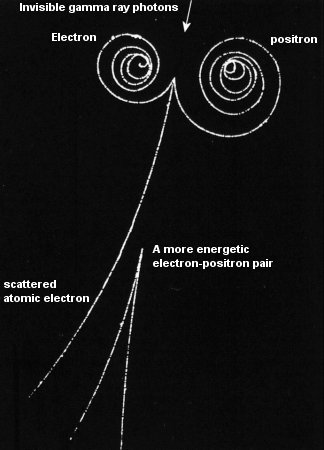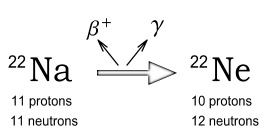Matter-Energy Conversion – part 2
Another aspect of the conversion between matter and energy involves the complete
transformation of subatomic particles into energy. In this situation oppositely charged
particles collide, completely annihilating each other in the process, and are converted
into energy in the form of photons. An even more impressive feat involves the inverse in
which particles are created out of energy.
Electron-Positron annihilation
This matter-energy conversion frequently takes the form of
electron-positron annihilation. Basically an electron and a positron (an anti-electron)
are drawn together due to their opposite charges. When they inevitably collide their
material existence comes to an end and they are turned into gamma ray photons.
In an opposite process, two gamma ray photons can be converted into an electron-positron
pair, bringing forth matter from whence none existed. Evidence for these interactions is
visible in bubble chamber experiments, such as shown below.

Here we see electrons and positrons produced simultaneously from
individual gamma rays within a bubble chamber. The particles curl in opposite directions
due to an applied magnetic field. The gamma rays don’t leave tracks in the chamber
because they have no electric charge.
This is certainly amazing. Somehow the hard and heavy substance of matter converts into
seemingly massless, sinusoidal electric fields, i.e. light waves, and vice-versa. How can
this be? This process cannot be easily explained in terms of momentum gains, as per the
previous chapter, since particles are newly created and fully disappear.
Examining the details
Let’s look more closely at the process of matter extinction.

Above we see an electron and positron hurtling toward each other in their
final moments of existence. In an instant from now they will collide, extinguishing both
mass and charge in a blinding flash, while converting into a pair of gamma ray photons.

How exactly does this take place? Standard science texts are silent on the
question; only reporting that it happens, but without providing any explanation of the
possible mechanisms involved. Unfortunately this is not very helpful. What we need is a
slow-motion version of events, particularly what happens at the moment the particles
‘make contact’.
There is no way of seeing anything on such a small scale. The best we can do is look at
the available evidence and speculate on what could be taking place. Ideally this
speculation should be something that makes sense in terms of a classical model. With that
in mind, the following is a version of what might be happening.
What if the particles didn’t annihilate, but instead ... passed through each
other.

That’s a radical suggestion certainly, and one totally at odds with
our everyday experience. After all, two bodies cannot occupy the same space and will put
up much resistance against any attempt to push them together.
Now recall from the previous chapter; the real reason everyday objects can’t be
pushed together is due to electrostatic repulsion from the surface electrons in the
object’s outer skins. In other words, mass does not resist, charge does; and
like-charged particles will resist being pushed together.
But an electron and positron are oppositely charged. They are unlikely to put up much
resistance at being pushed together. On the contrary, they will pull themselves together,
and since there is no resistance, perhaps overlap each other. No flashes, explosions or
annihilation. Just overlap.


Okay so the particles are now fully overlapping. What then? Both particles
came together at great speed. They still have momentum so there is no reason they should
stop here. Instead we would expect them to continue moving and come out of the overlap.


Now the particles have passed straight through each other and come out the
other side. Their positions have reversed and they are now moving away from each other. At
this stage the particles feel deceleration because force directions are reversed.
Eventually the particles slow to a stop.

At this point it appears that the process will repeat itself, then again,
and again. Basically the particles will oscillate through each other, as though connected
via a spring. Will the oscillation continue forever? This appears to be a frictionless
system.
As it happens, they won’t oscillate forever. The VDCL (Velocity Dependent
Coulomb’s Law) tells us that as oppositely-charged particles move together the force
between them decreases. As they move apart the force increases. This effectively acts as a
form of damping which will slowly bring the oscillation to a stop.
This animation shows the process involved.

Invisible particles
The oscillations have now stopped and we are left with an unusual
manifestation consisting of an electron and positron fully overlapping each other. This is
effectively a composite particle. It has twice the mass of an electron but more
importantly a charge of zero.
It goes without saying that a particle without charge is not going to have much of an
impact on anything, nor will it be impacted by anything. For all practical purposes it may
as well not exist. And that’s just the point. In electrical terms this composite
particle is effectively invisible. The electron and positron have not been annihilated
after all. They are still there.
We just can’t see them!
The production of light
There is one other aspect of the extinction process that needs explaining
and that is the emission of photons.
To understand this, consider radio transmissions. We know that when you oscillate
electrons in an antenna it produces radio waves, which are just low frequency
electromagnetic waves.
What if that antenna contained both electrons and positrons, and they oscillated in
opposing directions? Rather than cancel each other’s signal, the two sets of charges
would combine to produce a wave of double the amplitude.
Now look again at the electron-positron interaction. They are oscillating through each
other, just like in the antenna. Therefore we should also expect them to produce an
electromagnetic wave. In this case the frequency would be much higher due to the
lightweight nature of the particles involved. It may even be so high as to be in the gamma
ray spectrum.
Thus the most likely explanation for the emission of photons is that the brief oscillating
interaction between these particles produces an electromagnetic wave, or more correctly
two waves (one for each particle), which have frequencies in the gamma ray spectrum.
Electron-Positron creation
Now for the other side of the transaction where photons are converted into
matter; or in this case an electron-positron pair. Once again science has no rational
explanation for this amazing event. But armed with the above hypothesis on apparent matter
annihilation a simple explanation emerges.
For sake of discussion let’s call this composite positron-electron particle a
‘poseltron’. Is there any way for a poseltron to come undone, i.e. to be broken
into its constituent particles? One method would be to expose it to a strong electric
field which polarized the component particles and pulled them apart. But it would need to
be extremely strong because the positron and electron are in direct contact.
A more effective method of separating them might be to shake them apart. We know that one
method of destroying an object is to attack it with its natural frequency. For example
glass can be shattered by exposing it to sound waves that match its natural frequency of
vibration.
The poseltron came together while its components were oscillating at a certain frequency
corresponding to gamma radiation. Therefore it seems logical that if you exposed a
poseltron to gamma radiation of the same frequency, this would shake it apart.
I’m going to suggest that these poseltrons exist throughout nature and are
distributed everywhere. They may exist in average densities as low as one per cubic
centimetre, or the figure may be much higher. We have almost no awareness of them due to
their low mass and zero charge.
When a gamma ray comes along, or a group of rays (it would probably need several gamma
rays combined), and strikes a poseltron, it would be split into its component particles.
The result would be the apparent creation of an electron and positron, out of
‘nothing’.
The low density of poseltrons in nature would also explain why electron-positron pairs are
only created occasionally – there needs to be an existing poseltron in place before
conversion can occur. Under the current scientific model a photon with enough energy can
convert into an electron-positron pair, but would do so for no apparent reason, i.e. at
random without cause & effect. This model defies common sense.
Proton conversion
There is another way in which positrons can be created, and that is via a
process known as ‘proton conversion’. When Sodium-22, an unstable isotope of
sodium, decays it turns into Neon-22. In the process it releases a positron
(symbol=beta-plus) and a gamma ray photon. This diagram shows the process:

In the above diagram we see that the total number of nucleons
(protons+neutrons) is unchanged and one of the protons appears to have converted to a
neutron.
Standard theory holds that there are two means of proton conversion. One involves a proton
capturing an orbital electron and converting to a neutron. The other involves an
electron-positron pair being created followed by the electron being absorbed and the
positron ejected. Sodium-22 fits the second scenario.
In a later chapter it will be argued that a neutron is simply a proton and electron joined
together. So the proton-conversion-by-electron-absorption hypothesis may well be correct.
According to current science theory, Sodium-22 spontaneously, i.e. without cause &
effect, creates an electron-positron pair then converts one of its protons into a neutron.
This may be true but it raises a question about where the energy came from to create the
electron-positron pair in the first place since the nucleus apparently decayed without
external energy input.
A more likely description of events is as follows:
A poseltron drifts into the nucleus of a Sodium-22 atom.
The Sodium-22 nucleus contains a (not yet understood) oscillation motion
that closely corresponds to the frequency of electron-positron interaction.
This oscillation tears the poseltron apart into its component particles:
an electron and positron.
The electron is absorbed by a proton, converting it to a neutron.
The positron is ejected due to its positive charge (by the 11+ positive
nucleus).
Gamma radiation is generated by the positron-electron oscillation.
The full process
In summary, here’s how the matter-energy conversion process probably
happens.
An electron and positron are drawn together. They meet and pass through each other,
oscillating several times before coming to rest. The result is a zero-charge composite
particle (a poseltron) which is effectively invisible. The process of this oscillation of
charges produces gamma radiation.
“Look” says the scientist. “Matter has been converted to energy”.
Not so. The matter is still 100% there. And that ‘energy’ is nothing more than
sinusoidal electric fields created by the motion of the oscillation.
Next some gamma rays, possibly resulting from a similar interaction, come along and happen
to stumble on the poseltron. They shake its component particles apart and scatter them. At
the same time these particles absorb some of the incoming radiation.
“Look” says the scientist. “Energy has been converted to matter”.
Again, no. Nothing has been created; that matter was always there. It’s just that now
you can see it because the charges are able to interact with other matter.
Bottom line: no conversion has taken place, it just looks that way. |





